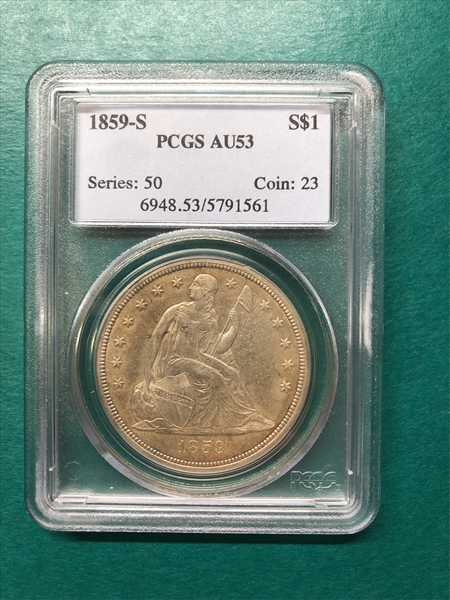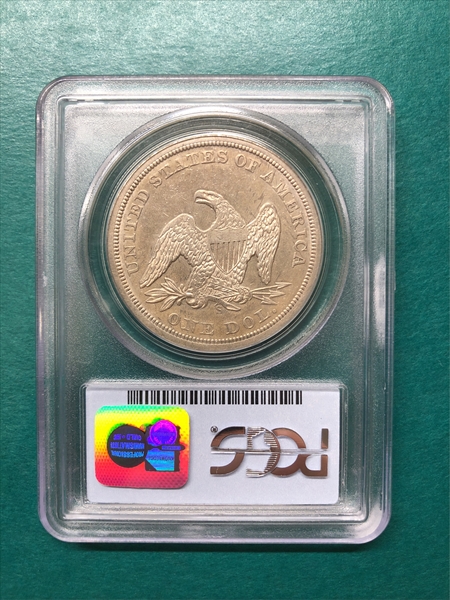1859-S $1 AU53 认证号05791561, PCGS号6948
专家评论
Q. David Bowers
The following narrative, with minor editing, is from my "Silver Dollars & Trade Dollars of the United States: A Complete Encyclopedia" (Wolfeboro, NH: Bowers and Merena Galleries, Inc., 1993).Coinage Context
Background: The silver dollars of 1859 struck at the San Francisco Mint were minted primarily for use in foreign trade.
From 1853 through 1857 about twice as many silver dollars were coined on the average than during the preceding six years, as after the weight reduction of 1853 the silver dollar was the only silver coin acceptable in the export trade. The lightweight (after February 1853) half dimes, dimes, quarter dollars, and half dollars were not wanted.
As the supply of domestically mined silver in the United States was very small during these years, most dollars were minted from melted-down foreign coins taken from circulation and from bullion imported from Mexico (which had an abundant supply).
Trade demands increased, and production of silver dollars at all mints combined went over the 600,000 mark in 1859 and over the 700,000 mark in 1860. San Francisco was the most important embarkation point for trade with China. To minimize risks and costs of shipping silver dollars from Philadelphia or New Orleans, in 1859 for the first time the San Francisco Mint coined this denomination.
Neil Carothers, in Fractional Money (pp. 149-150), noted the following (Carothers obtained this information from Bankers Magazine, Vol. 8, p. 932.) "In 1859 local [San Francisco] merchants presented bullion for coinage into silver dollars for export. When Director Snowden refused the superintendent's request for dies, that official insisted, saying there was a great excess of subsidiary silver in California which might possibly be relieved by the coinage of silver dollars. Snowden yielded to this absurd suggestion." (But see the following quoted passages, which tell a different story.)
The silver trade situation: John M. Willem, in The United States Trade Dollar, quotes a letter from Charles H. Hempstead, superintendent of the San Francisco Mint, dated November 18, 1858, writing to Director James Ross Snowden that in San Francisco:
We are now attracting to our shores large quantities of silver, in bars, from Mexico, for which we pay in silver coins. By reference to your letter of the fourth of August last, I find that you say that single "silver deposits may be received, but they are only payable in silver dollars or in fine silver bars." We have never received any dies for silver dollars, nor am I aware of the reason why this branch has never made that denomination of coin. I would, therefore, suggest that the coinage of silver dollars (if it be not contrary to the policy of government) would relieve us of just one-half of the labor now necessary in the coinage of large quantities of Mexican silver. (This is in reference to the coining in San Francisco of silver dimes, quarters, and half dollars. It cost nearly twice as much to coin a given amount of silver into two half dollars as it did to make one single dollar, and several times as much to coin 10 dimes.)
On February 19, 1859 Snowden sent this reply:
As the facts stated by you indicate the propriety of coinage of silver dollars at your branch of the mint, I have caused four pairs of dies of that denomination to be prepared and forwarded to you per express. A weight for the adjustment of the coin (from which others can be made) will be found in the box containing the dies.
The San Francisco Bulletin, as quoted by Willem, commented:
The authority to coin silver dollars, received by mail yesterday, is quite an object to the commerce of the Pacific Coast. Crude silver has today been deposited for coinage to the amount of upward of $7,000 by one house in the Mexican trade.
The same source noted that on August 1859 Merchants Magazine related that" every vessel leaving San Francisco for Chinese ports takes a large amount of Mexican dollars."
San Francisco mintages: Only 20,000 1859-S dollars were minted, and few others at San Francisco after that: a trivial number in 1870, a small amount in 1872, and only 700 in 1873. Why? Apparently, because Chinese traders preferred Mexican dollars, heavier than the U.S. counterparts. The San Francisco Mint instead coined increasing numbers of half dollars through 1877 (and trade dollars 1873-1878). (Walter H. Breen, letter to the author, February 12, 1992.)
Numismatic Information
1859-S circulated grades: As the entire mintage of 1859-S went to the Orient, the 1859-S is scarce in all grades, but, curiously, is more available than the low mintage of 20,000 indicates. Why? Did some return to the United States after specie payments resumed? Most known survivors are in Very Fine and Extremely Fine grades. Coins showing mint lustre are rare.
Availability of Mint State grades: Few if any 1859-S dollars were deliberately saved at the time of issue, and by the time that William Sumner Appleton, Augustus G. Heaton, and other aficionados of mintmarks began saving them, virtually all Mint State coins had disappeared. Not even the Mint Cabinet received one, though Superintendent Robert Aiken Birdsall had sent the first 1854-S $20 (a Proof) for display purposes. Still, a few exist today within the numismatic community, undoubtedly representing coins saved by chance. These few grade at or near the MS-60 level. Most older price quotations and auction listings for Uncirculated 1859-S dollars, published before 1986, must be discarded in research, for most "Uncirculated" pieces seen have been AU or less in terms of today's strict grading. Further, it is the opinion of John W. Dannreuther and some others that certain 1859-S dollar listings in certification data represent multiple submissions of the same coin. (In his chapter in The Comprehensive U.S. Silver Dollar Encyclopedia).
In an essay written in 1982, Bruce Amspacher stated that he knew of no 1859-S dollars in MS-65 or better grades. ("Liberty Seated Dollars," article in the Monthly Summary, The Coin Dealer Newsletter, July 1982.) This was before the hobby-wide revision of grading interpretations that took place in 1986. Thus, Amspacher might well have been referring to coins which would grade MS-63 or so today.
Varieties
Circulation strikes:
1. Normal Date: Breen-5461. Obverse: Date digits without repunching. Reverse: Medium-size S mintmark.
2. Normal Date: Breen-5462. Obverse:
Repunching is seen at the bases of the first two digits, apparently fading away as the die becomes worn. (A VF specimen owned by Harry E. Smith, examined by the author in August 1992, had no repunching but was from this die pair; apparently, it was a later state.)Date close to base of Liberty. Reverse: Medium-size S mintmark, high and almost touching olive branch.
Notes: At least one has the reverse die rotated 20° out of normal alignment to the right.
(Lawrence N. Rogak, "Rotated Reverses on Liberty Seated Dollars." Article in The Gobrecht Journal, July 1990. The author examined five coins and found one with rotated reverse. The rarity of the variety is unknown, nor is it known if others have the reverse rotated to the same degree (if the die was loose, rotation degrees could vary). Also see 1869.) 10 pairs of dies were shipped to San Francisco for the 1859 coinage, but, apparently, most remained unused.
Dies prepared: Obverse: 10; Reverse: 10 Circulation strike mintage: 20,000
Estimated quantity melted: Most of the mintage was exported to China; there melted
Characteristics of striking: Usually well struck Known hoards of Mint State coins: None
Commentary
First and largest coinage of Liberty Seated dollars in San Francisco. 1859-S silver dollars were coined expressly for export to China. The issue is a rarity in Mint State.
Additional Information
Mexican Coins to be Struck in the U.S.
To help ameliorate the shortage of heavyweight silver coins for export from San Francisco, a private firm, Duncan, Sherman & Company, of New York, proposed to set up a mint in San Francisco to produce silver pesos similar in design, weight, and fineness to those produced under government authorities in Mexico, this operation to be supervised by Mexican assayers, and with a seigniorage of 1% to be paid to the Mexican government for the first 14 years of the contract and 1-1/2% thereafter. Presumably most silver bullion would have come from Mexico. After due consideration and preparation of contracts, the idea was dropped.
Less than 20 years later, the Philadelphia Mint would begin making coins in quantity for foreign governments; three generations later, so would branch mints; more recently, private mints in the United States followed suit. In 1949, the San Francisco Mint restruck 2,000,000 1898-dated Mexican silver pesos, Mo mintmark, AM assayer 's initials, for export to Chiang Kai-Shek and the Republic of China, and the Mexico City Mint restruck 8,250,000 similar pieces (originals made in Mexico in 1898 have 139 beads around the reverse border; 1949 restrikes have 134).
PCGS #
6948
设计师
Christian Gobrecht
边缘
Reeded
直径
38.10 毫米
重量
26.73 克
铸币数量
20000
金属成分
90% Silver, 10% Copper
更高评级数量
53
评级较低的钱币数量
250
地区
The United States of America
价格指南
PCGS 数量报告
拍卖 - PCGS 评级的
拍卖 - NGC 评级的
稀有性和存量估计 了解更多
| 所有评级 | 1800 |
| 60或以上 | 35 |
| 65或以上 | 0 |
| 所有评级 | R-4.6 |
| 60或以上 | R-8.8 |
| 65或以上 | R-10.1 |
| 所有评级 | 19 / 30 TIE |
| 60或以上 | 4 / 30 TIE |
| 65或以上 | 1 / 30 |
| 所有评级 | 29 / 45 TIE |
| 60或以上 | 10 / 45 TIE |
| 65或以上 | 1 / 45 |























